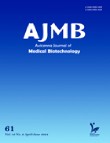The Role of Dihydropyrimidine Dehydrogenase and Thymidylate Synthase Polymorphisms in Fluoropyrimidine-Based Cancer Chemotherapy in an Iranian Population
The fluoropyrimidine drug 5-Fluorouracil (5-FU) and the prodrug capecitabine have been extensively used for treatment of many types of cancer including colorectal, gastric, head and neck. Approximately, 10 to 25% of patients suffer from severe fluoropyrimidine-induced toxicity. This may lead to dose reduction and treatment discontinuation. Pharmacogenetics research could be useful for the identification of predictive markers in chemotherapy treatment. The aim of the study was to investigate the role of five genetic polymorphisms within two genes (DPYD, TYMS) in toxicity and efficacy of fluoropyrimidine-based chemotherapy.
Total genomic DNA was extracted from 83 cancer patients treated with fluoropyrimidine-based chemotherapy. In this study, three polymorphisms were genotyped in dihydropyrimidine dehydrogenase gene c.1905+1 G>A (DPYD*2A; rs3918290), c.1679 T>G (I560S; DPYD*13; rs55886062), and c.2846A>T (D949V; rs67376798) and two polymorphisms, besides the Variable Number of Tandem Repeat (VNTR) polymorphism and 6-bp insertion/deletion polymorphism in thymidylate synthase gene. The analysis of polymorphisms for rs3918290, rs55886062, rs67376798 and 6-bp insertion/ deletion in TYMS was done by Polymerase Chain Reaction-restriction Fragment Length Polymorphism (PCRRFLP) TYMS VNTR analysis. 5-FU-related toxicities such as anemia, febrile neutropenia, neurotoxicity, vomiting, nausea, and mucositis were evaluated according to NCI-CTC criteria version 4.0. T-test and chi-square were used and p-values less than 0.05 were considered statistically significant.
DPYD gene polymorphisms were not observed in this study. The frequency of the TYMS +6 bp allele was 40.35% and the -6 bp allele was 59.65% in this study. The frequency of VNTR 2R allele was 48.75% and 3R allele was 51.15%. Toxicity grade II diarrhea, mucositis, nausea, vomiting, and neurotoxicity was 2.2, 24.1, 15.7, 6, and 51.8%, respectively. Thymidylate synthase ins/del polymorphisms were associated with increased grade III neurotoxicity (p=0.02). Furthermore, anemia grade III was significantly associated with 2R/2R genotype (0.009).
Thymidylate synthase gene polymorphisms may play a key role in fluoropyrimidne -based chemotherapy. Although rare DPYD polymorphisms were not observed in our study, according to large population studies, DPYD gene polymorphisms could be used as a predictive biomarker for patient treatments.
- حق عضویت دریافتی صرف حمایت از نشریات عضو و نگهداری، تکمیل و توسعه مگیران میشود.
- پرداخت حق اشتراک و دانلود مقالات اجازه بازنشر آن در سایر رسانههای چاپی و دیجیتال را به کاربر نمیدهد.



